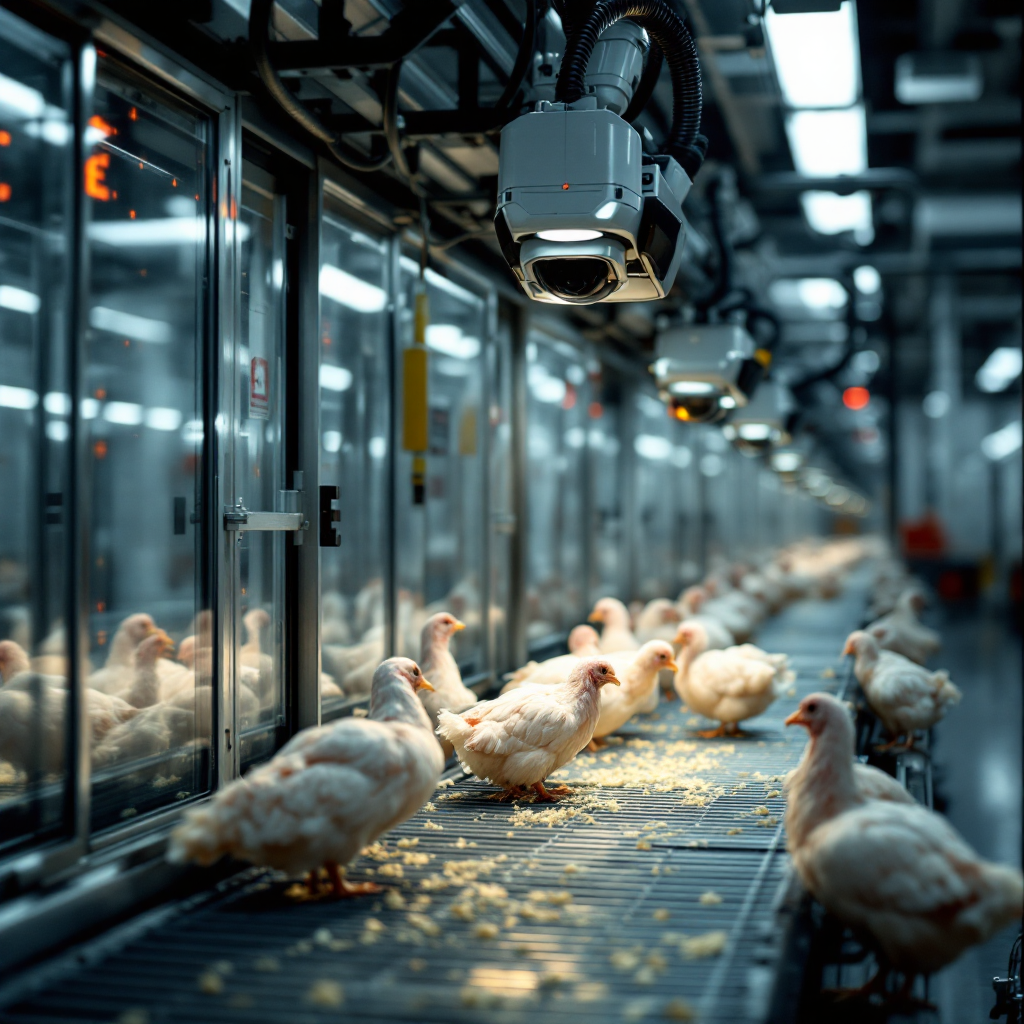AI and Analytics in Poultry Production
AI video analytics means using cameras, machine learning and software to inspect birds, cuts and lines automatically. For poultry processing lines this technology turns video streams into structured events. Then operators get fast alerts and clear metrics. Cameras mount over conveyors, chillers and packing stations. In addition, top-down and angled views combine to maximise poultry house coverage and reduce blind spots.
Cameras feed images to computer vision pipelines. First, frames undergo preprocessing to correct lighting and perspective. Next, detection models find items of interest. Finally, classification or segmentation models label defects and measure size. Convolutional neural networks such as YOLOv8 have achieved high performance. For instance, CNNs can exceed 90% accuracy for conditions like woody breast and bumblefoot in recent trials. This level of precision shortens inspection time. It also lowers the risk that defective poultry products leave the plant.
Compared with manual inspection, automated inspection scales with throughput. People get tired, have inconsistent judgment and cannot sustain high sampling rates. AI systems operate continuously and provide repeatable scores. Processing plants can therefore automate sorting at full line speed, which boosts yield and reduces rework. Real-time alerts let staff isolate suspect items instantly, which improves product safety and supports audit trails.
Visionplatform.ai integrates with existing VMS to repurpose CCTV as sensors. Our platform helps plants own their models and data, so training can use site-specific footage while keeping data on-prem. That approach supports GDPR and EU requirements. For operations teams, structured events stream to dashboards and production systems. For more on counting and occupancy applications that share technical patterns with line counting, see our people-counting solution people-counting in airports.
Also, automated processing reduces labour cost and sampling bias. In short, this combination of cameras, deep learning and event streaming modernises poultry production and supports real-time decision making while keeping traceability intact.
Applications in Poultry for Health Monitoring
AI enables fast, breed- and line-specific health monitoring that runs alongside processing. For example, models detect bumblefoot and woody breast in carcasses and live birds. They mark anomalies so that trained staff can review images quickly. Field studies show the methods detect these conditions with high accuracy and consistency compared with manual checks. As a result, plants remove compromised items earlier and reduce downstream waste.
In parallel, AI links to molecular diagnostics and biosensors to improve sensitivity for poultry diseases. When a camera flags an unusual gait or lesion, the system can trigger a follow-up test and log that test result against the video. Combining vision with sensor feeds creates a richer monitoring system and enables predictive alerts for flock health. This integration helps maintain flock health and supports proactive interventions before outbreaks escalate in reviews of AI for productivity.
Systems process video data from multiple lines and can screen thousands of birds or eggs per hour. Real-time output lets supervisors prioritise samples and isolate probable cases for laboratory confirmation. For on-premises deployments, Visionplatform.ai can run learning models at the edge so that sensitive footage never leaves the site. This design helps plants maintain compliance while benefiting from modern ai technologies. Also, by automating repetitive checks, staff can focus on complex diagnostics and decision making rather than continuous visual inspection.
Finally, linking plant-side insights back to the farm supports better poultry farm management. When processing treats reveal recurring lesions or trends, those signals feed into farm-level adjustments. That feedback loop helps improve breeding, nutrition and vaccination decisions, which raises overall flock health and reduces losses for commercial poultry operations.

AI vision within minutes?
With our no-code platform you can just focus on your data, we’ll do the rest
Welfare Monitoring and Poultry Welfare Monitoring
AI tracks behaviour and welfare indicators across handling and processing zones. Cameras observe posture, movement patterns and vocal cues. Then software scores behaviours to highlight distress, injury or abnormal motion. This kind of welfare monitoring supports both regulatory compliance and ethical practice. In many plants, video-based welfare assessment speeds audits and records evidence for inspectors.
Specifically, models monitor gait changes, wing droop, and head carriage to identify poultry behavior that suggests pain or discomfort. The system also records sudden clustering or continued immobility that can indicate environmental issues in a poultry house. Alerts trigger immediate checks and interventions, so staff can act before harm spreads. When paired with on-site sensors, the monitoring system links environmental data to behaviour. For instance, temperature spikes or CO2 rises correlate with increased agitation, and cameras confirm the animal response.
For audit-ready logging, Visionplatform.ai streams events to operational dashboards and retains auditable logs of detections. That workflow helps plants meet welfare standards and creates a documented trail for welfare assessment. Also, the same approach that powers process anomaly detection in security contexts applies here. For technical parallels, engineers may review our process anomaly work to understand event streaming and alert thresholds process anomaly detection in airports.
By automating welfare surveillance, teams reduce reliance on periodic human checks and achieve continuous oversight. This makes overview of flock health more granular. Therefore, animal welfare improves and compliance becomes easier. The link between behaviour and welfare leads to practical changes at scale. Overall, AI-based poultry welfare monitoring supports humane poultry operations while enabling plant managers to act faster and more confidently.
Enhancing Poultry Welfare in Poultry Farming
Insights from processing plants feed back to farms. Data-driven loops let farmers correct issues earlier in the production cycle. For example, if a processing line shows rising incidence of bruising or lesions, managers trace the problem to transport, housing or handling. Then supply chain teams adjust crate design, handling practices or rest times to reduce harm to the flock. This tight feedback loop helps improve animal welfare on both farm and plant.
Visionplatform.ai supports that loop by making events available to operations and farm teams through MQTT or webhooks. Teams can therefore see trends and export clips for training. When farm managers receive this information they refine poultry management practices. They adjust stocking density, ventilation, and enrichment. Those changes reduce stress and lower disease risk in the flock.
One case example: a processor noticed increased wing damage during receiving. Video clips showed sharp turns during unloading and unexpected jostling. The plant team shared clips with the farm logistics manager. After adjusting transport crates and training handlers, the damage rate fell by a measurable margin. This improvement raised yield and reduced trim loss.
Feedback also improves breeding choices. Processing metrics reveal subtle, heritable traits such as susceptibility to woody breast. Breeding programs use that data to select for harderier lines. Over time, this reduces clinical issues and increases welfare indicators across the flock. In short, data that begins on the plant line informs on-farm decisions and helps create more humane poultry and improved productivity.

AI vision within minutes?
With our no-code platform you can just focus on your data, we’ll do the rest
Sustainable Poultry Production through Artificial Intelligence
AI helps reduce waste and resource use in modern poultry farming. Early detection of defects prevents contaminated or low-quality poultry products from advancing. That lowers rework and disposal volumes. For example, vision systems flag blemished cuts earlier so plants trim less and send fewer items to waste streams. This saves energy and reduces greenhouse gas impacts across the supply chain.
Resource optimisation follows when data guides feed, water and energy allocation. Continuous monitoring shows where birds cluster and how they use space. Managers then adjust heating zones, ventilation schedules and feed delivery patterns to match actual need. These changes lower utility consumption and improve bird comfort. The result is a measurable improvement in sustainability of poultry operations.
Economically, deployment of AI reduces labour in routine inspection while increasing yield. Plants gain throughput without scaling headcount. Additionally, high-accuracy ai models reduce false positives and ensure staff time focuses on real issues. According to industry reviews, automated systems provide consistent inspection performance that outperforms manual checks in comparative studies. Lower labour costs, higher yield and less waste translate into stronger margins and a smaller carbon footprint.
For commercial poultry and processing teams, combining vision with predictive analytics unlocks further savings. Predictive models forecast peaks in trim or rejects so planners can smooth production. When operations and farm teams coordinate, feed conversion and mortality fall. That coordinate approach supports sustainable poultry production and makes better use of farm resources.
Future of Sustainable Poultry with AI
The next phase will link AI with IoT, robotics and ledger systems for full-chain transparency. Cameras combine with sensors, automated sorters and robots to create closed-loop workflows. Blockchain and auditable logs document provenance and welfare history. This integration supports traceability, so buyers can verify humane poultry claims and sustainability metrics.
Nonetheless, challenges remain. Models need large labelled datasets and careful annotation. Cost of edge hardware and integration can be a barrier for smaller operators. Also, developers must refine accuracy for rare conditions. Research shows that open datasets since 2019 help accelerate model development and reduce data scarcity. Progress continues in deep learning and in model efficiency, which lowers deployment cost.
Regulatory support will encourage adoption. As standards evolve, plants that own their models and data will find it easier to meet requirements. Visionplatform.ai designs systems to run on-prem and keep data local, which eases compliance with EU AI Act considerations. For practical examples of how video events power operations and alerts, see our forensic search solution for incident review forensic search in airports.
Finally, the potential to revolutionize poultry farming grows as more farms and plants share anonymised outcomes and best practices. Combining vision with sensors and automation will drive humane poultry, better yields and lower environmental impact. For teams considering pilots, focusing on clear use cases—welfare monitoring, defect detection and automated monitoring of line speed—yields tangible returns and builds momentum for wider AI integration.
FAQ
What is AI video analytics for poultry processing plants?
AI video analytics uses cameras and machine learning to inspect poultry and processing lines automatically. It turns video data into alerts and metrics so teams can act faster and more precisely.
How accurate are AI models at detecting common poultry health issues?
Modern deep learning models can exceed 90% accuracy for specific conditions like woody breast and bumblefoot in controlled studies source. Accuracy depends on image quality and training data tailored to the site.
Can these systems work with existing CCTV and VMS?
Yes. Platforms such as Visionplatform.ai repurpose existing cameras and VMS to become operational sensors. That reduces capital costs and speeds deployment while keeping data on-prem.
Do AI video systems help with animal welfare compliance?
They do. Continuous welfare monitoring provides auditable logs and video clips that support welfare assessment during audits. Alerts also enable timely interventions to improve animal welfare.
How do plants combine vision with lab diagnostics?
Vision systems flag suspicious cases and then trigger follow-up molecular testing or biosensor checks. This two-step approach increases sensitivity and reduces unnecessary testing.
Will AI reduce staff numbers in poultry plants?
AI automates repetitive inspection tasks, which lowers routine workload. However, it reassigns staff to higher-value tasks such as investigation, maintenance and process optimisation.
Is data kept private when using AI solutions?
On-prem deployments keep video and training data on-site, which supports GDPR and emerging EU AI Act requirements. Visionplatform.ai offers edge and on-prem options for customer control.
How does AI contribute to sustainable poultry production?
By detecting defects early, AI reduces waste and trim loss. It also enables resource optimisation for feed, water and energy, lowering the carbon footprint of poultry products.
What challenges should I expect when deploying AI?
Common challenges include gathering labelled data, tuning models to site-specific conditions, and upfront hardware costs. Open datasets and edge-efficient models are helping to lower these barriers.
Where can I learn more about operational use of camera events?
Explore how event streaming can support operations and BI by reviewing cross-industry solutions such as process anomaly detection and people-counting; these explain patterns that map to line and welfare monitoring process anomaly detection in airports, people-counting in airports.

